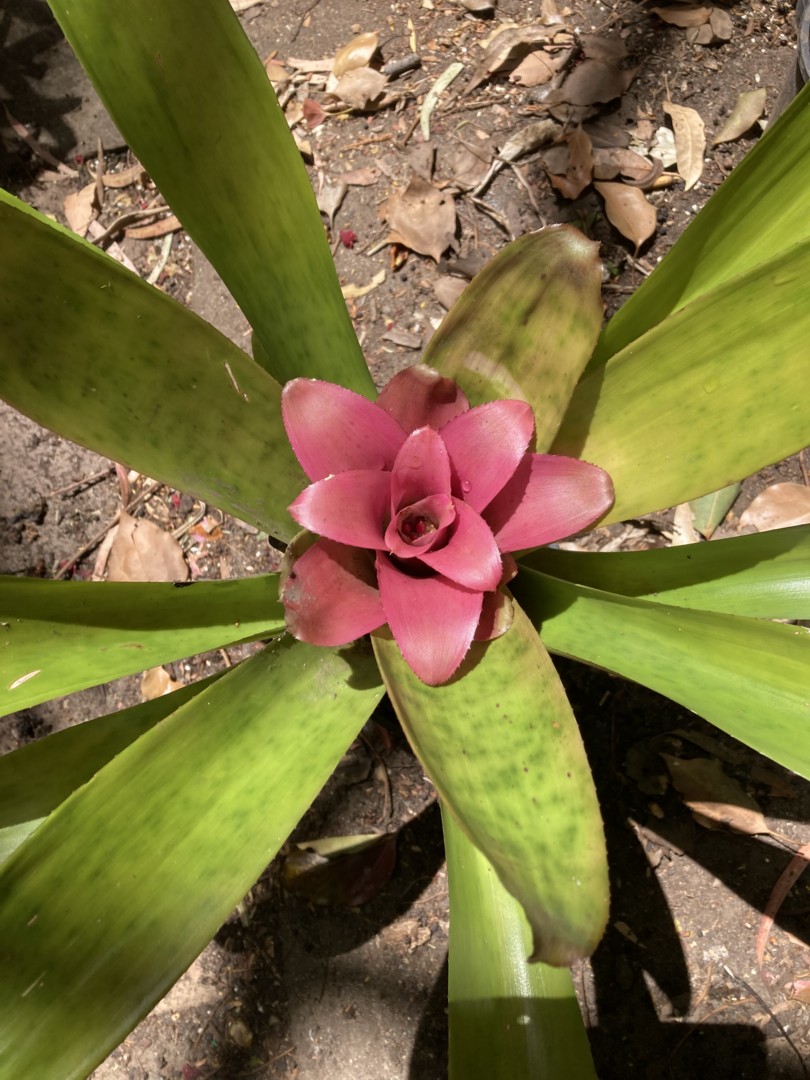
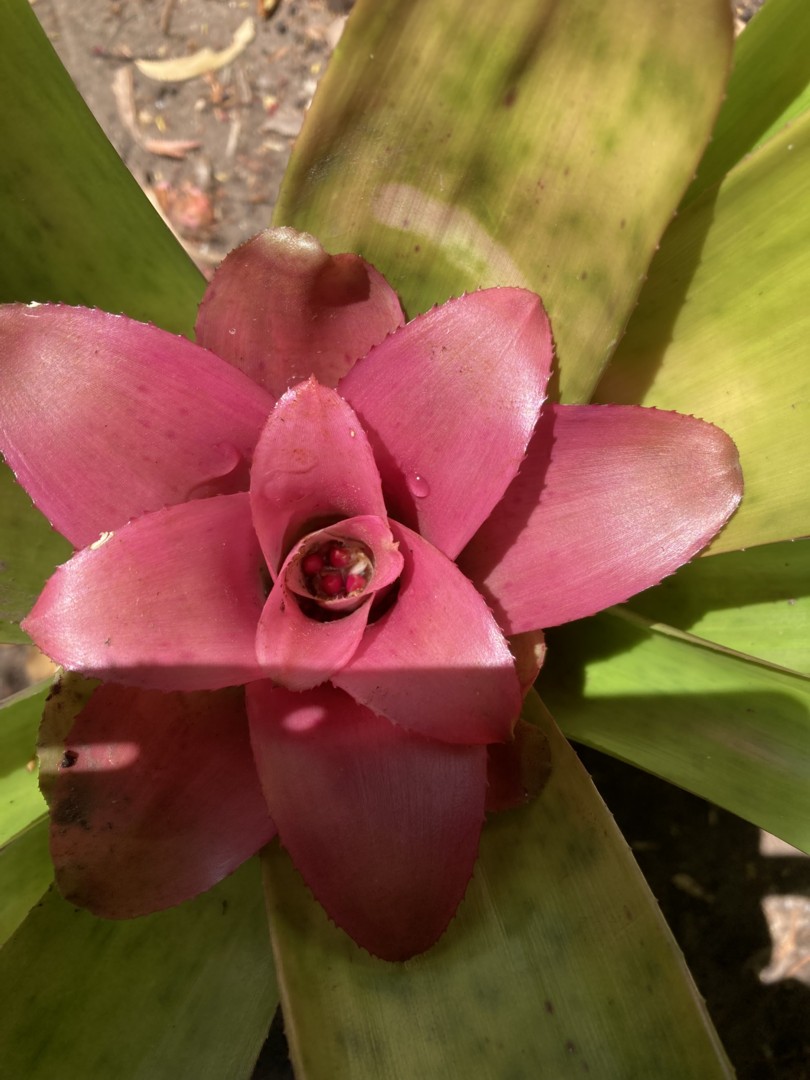
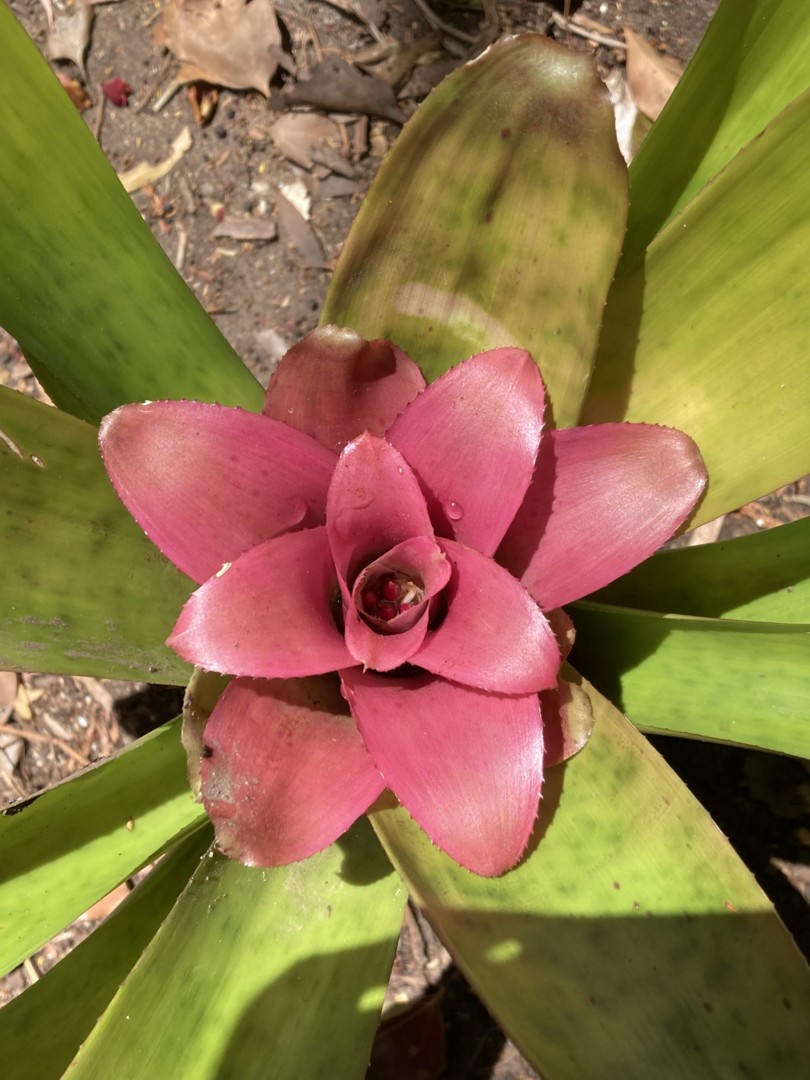
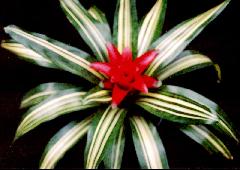
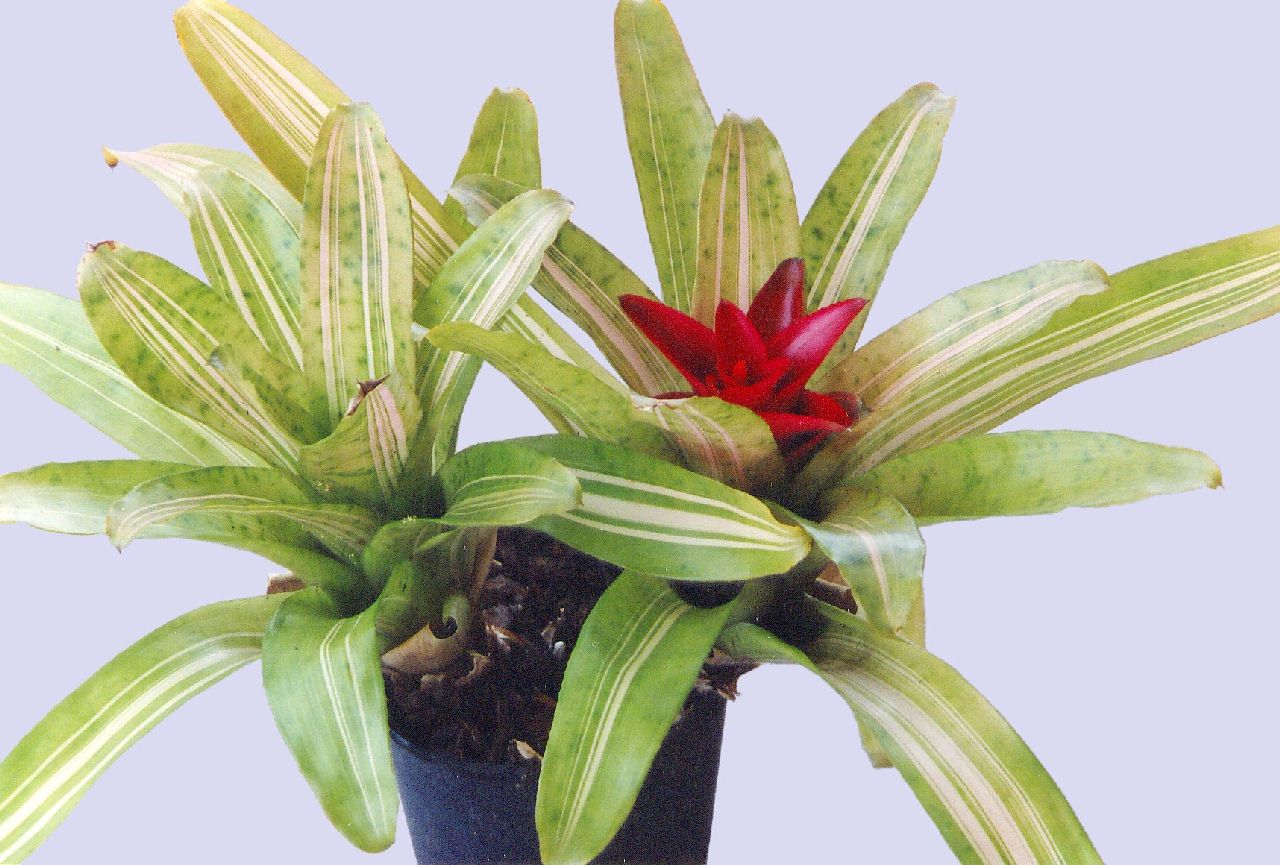
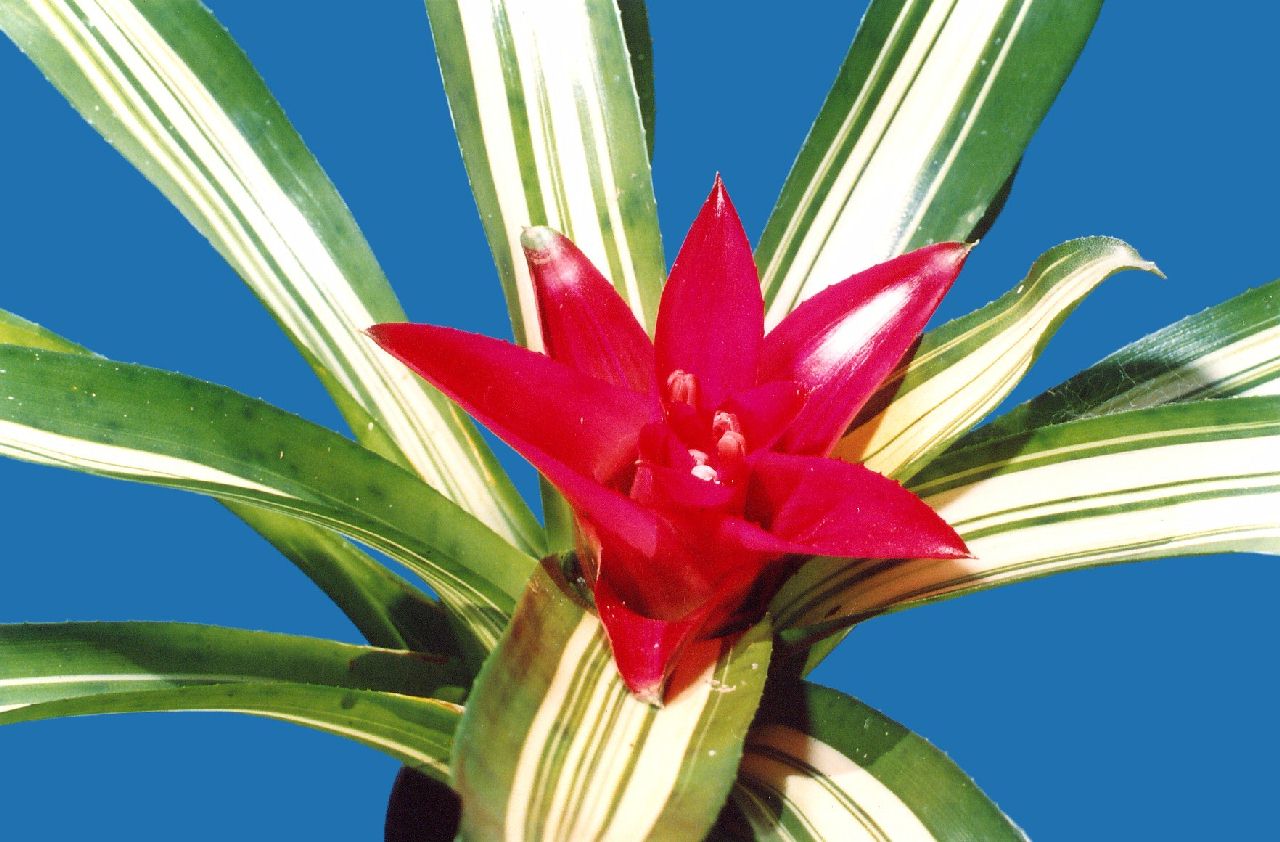
Plants evolve in the wild where it is mostly, survival of the fittest. Plants in cultivation face a different sort of survival depending on the whims and fancies of growers. When the BCR was first published in 1998 there were a few Neoregelia names published with the comment "Grace Goode indicated that she felt this plant was not still in cultivation". The problem here was that when I was Registrar after 1998 I came across some that had actually survived. In other words nobody knows where or how selected plants survive in captivity. The more you read the BCR entries the more you realise that some of them are seemingly extinct after only a short space of time i.e. 5 years whereas others have survived. In this case it has survived since the 1980's. In fact it got a mention in New Standardized Cultivar Names by Nat De Leon, BSI Hybrid Registrar in Journ Brom Soc 35(1): 34-37. 1985 but regrettably not according to the ICNCP rules on variegated plants. I quote "Nidularium regelioides 'Variegata' (syn. rutilans variegata)".
I put my query to Ross Little and he confirmed he had this plant alive and had been popular with the Buchanan's when they owned Pinegrove nursery. Their records showed they had received the plant from various sources as follows BBK #350, Nidularium rutilans variegated, 4/83 Schaefer, 4/85 Sax, 8/85 Goode, Schaefer, 1/86 Wasley, 6/86 Gleeson.. None had claimed being the first to notice the variegation so it would appear it originated in either Europe or the USA. I did consider Brazil but Seidel does not have it in their catalogues. It is in Kent's 1979 catalogue under Nid. rutilans variegata and in 1981 Tropiflora under Nid. regelioides variegata.
Sometimes the primary bracts can be variegated too.
As for the name, you can thank Ross Little for that.
Nidularium rutilans E. Morren, Belgique Hort. 35 81.1885.
Detail from Leme in Nidularium –Brom. Atl. Forest. 132-6. 2000
Synonym. Karatas rutilans (E. Morren) Baker, Handb Bromel 9.1889
Nidularium regelioides Ule, Ber. Deutsch. Bot. Ges. 16: 351, pl. 22, fig. 9.1898.
Type: Sumidouro (Nova Friburgo), Dona Mariana, fl.Jan. 1898, E. Ule 4666 (holotype. B, lost). Syn. nov.
LEAVES 12 to 20, suberect-arcuate to spreading at anthesis, subchartaceous, forming a dense, broad crateriform rosette:
SHEATHS elliptic, 11-15 (-20) x 6-10 cm, subdensely brown lepidote, pale-brown near the base, green to slightly purplish toward apex;
BLADES sublinear, slightly if at all narrowed at base, 15-50 x 4-7 cm, glabrescent or inconspicuously and sparsely white-lepidote, green with sparse irregular dark green spots, apex acute to rounded and apiculate, margins inconspicuously sub densely to laxly spinulose, spines less than ca. 0.5 mm long, 5-11 mm apart.
SCAPE 5-9 cm long, ca. 1 cm in diameter, distinctly shorter than the leaf sheaths;
SCAPE BRACTS the lower ones subfoliaceous, the upper ones resembling the primary bracts but smaller, greenish.
INFLORESCENCE tripinnate, capitate-rosulate to substellate, 6-7 cm long, 10-18 cm in diameter, slightly exceeding the leaf sheaths, but sunken in the rosette and not elevated above it;
PRIMARY BRACTS long ovate, apex subacute to rounded and minutely apiculate, sub erect but subspreading toward apex, bright red or lilac, inconspicuously and sparsely white lepidote toward base, subdensely and minutely spinulose toward the apex, spines ca. 0.5 mm long or shorter, the lower bracts 10-15 x 5.5-8 cm;
FASCICLES ca. 10, the lower ones 30-40 x 20-35 mm, 4-to-6-flowered;
FLORAL BRACTS oblong-elliptic to ovate-lanceolate, apex acute to subrounded and minutely apiculate, entire or remotely spinulose at apex, 20-30 x 10-20 mm, membranaceous, sparsely white-lepidote with lacerate trichomes, hyaline toward base and red toward apex, from equaling the middle to the apex of the sepals.
FLOWERS 45-70 mm long, subsessile;
SEPALS subsymmetrical, oblong-elliptic, apex acute to subrounded and apiculate, 17-22 x 6-8 mm, connate for 3-5 (-7) mm, red to lilac toward apex, glabrous;
PETALS 40-50 mm long, tube 30-36 mm long, greenish-white, lobes 10-14 x 6 mm, pale lilac near the base and bearing 2 distinct callosities, coral-red toward apex, pale pink to brownish after anthesis;
ANTHERS 5-8 mm long, apex distinctly apiculate;
STIGMA subglobose, blades with densely lacerate margins;
OVARY subclavate, 10-15 mm long, ca. 5 mm in diameter.
FRUITS white, persistent calyx red to purplish.
TYPE: Morren Icon (lectotype. K, here designated)
Clonotype: Rio de Janeiro, fl. Cult. 1885 under the number 111, A. Glaziou 16444 (P, n. v., photo HB).
ETYMOLOGY
The Latin word rutilans means "red tinged with gold" depicting the bright red primary bracts of this species as it appeared in Edouard Morren's painting.
DISCUSSION
When Edouard Morren described N. rutilans in 1885, based on a specimen (# 111) that A. Glaziou had sent from Brazil in 1883, he stated in the protologue that this species was different from all others in its red corollas, lovely red primary bracts with pinkish hues and leaves mottled dark green. Morren's painting of N. rutilans, today part of the collection of the Royal Botanic Gardens at Kew, England, is an accurate representation of the species.
Although the protologue refers explicitly to specimen Glaziou 111, therefore considered to be the holotype of the species, this herbarium sheet was not found at the University of Liege, in Belgium, where it should be deposited. I found one sheet of N. rutilans at this institution containing only leaves. There was no inflorescence nor was there any annotation that would associate it with the original material used by Morren. Therefore, in the absence of the holotype, E. Morren's painting should be chosen as the lectotype of this species according to Art. 9.2 of the Tokyo Code (Greuter et al., 1994). However, the herbarium of the Natural History Museum in Paris has a specimen from Rio de Janeiro that was cultivated by A. Glaziou in Sao Cristovao aand flowered in 1885. This material has two numbers' #16444 and #111. The former certainly must be Glaziou's collection number, while #111, mentioned in the protologue of N. rutilans, apparently refers to the number of the plant in cultivation. This herbarium sheet also has the inscription "Nidularium rutilans Morr. n. sp." which may have been written by Glaziou. So, although it cannot be directly related to the data given in the protologue, this material probably came from the same cultivated source (#111) as the specimen used by Morren. This material trom Paris is considered to be the clonotype of N. rutilans based on a photograph that I only received in March 2000.
Nidularium regelioides was included here as a new synonym of N. rutilans. It was described by E.Ule in 1898 based on a specimen (#4666) that he himself had collected some months earlier in the Dona Mariana area, today part of Sumidouro municipality in Rio de Janeiro. In the protologue, Ule stressed the more spinose nature of N. regelioides that distinguished it from N. rutilans. Although the holotype of the species, deposited in the herbarium of the Berlin-Dahlem Botanical Museum in Germany, was destroyed during World War II, I did examine a floral fascicle of specimen Ule 4672, also collected at the type locality of N. regelioides and identified as such by Ule himself. The floral bracts of this species, as described by this botanist, were spinulose
" bracteolis florigeris (...) margine distincte serrulato-dentatis"
and not very discrepant, falling within the limits of variation observed in N. rutilans.
Furthermore, the petals and sepals of this specimen were totally compatible with those of N. rutilans, thus supporting the idea that these taxa are not distinguished by any important differences and should therefore be placed in synonymy.
Although N. regelioides has not been recollected in the Dona Mariana region in spite of several unsuccessful attempts, this historical locality is included in the area occupied by N. rutilans, which stretches from northern Rio de Janeiro state to the northern Sao Paulo coast.
Nidularium rutilans is characterized by a compact leaf rosette with green leaves mottled dark green and provided with tiny spines. The floral rosette, compared to the leaf rosette, is dense and well developed. In some specimens the leaf spots are not very conspicuous, in others the inflorescence diameter may equal nearly half the diameter of the leaf rosette. The primary bracts of N. rutilans are bright red, or they may be wine-red or rarely, reddish purple as in a specimen collected by A. Seidel. Seidel's specimen does not have a precise collection locality, so this color extreme should be viewed with caution.
Because of the distinctly mottled leaves with a rounded apex, or nearly so, and/or the primary bracts with apex also rounded, or nearly so, this species constitutes a subcomplex together with N. espiritosantense, its closest relative, in the "red complex". Compared to N. espiritosantense, N. rutilans is distributed farther to the south, in Rio de Janeiro and Sao Paulo (not Bahia and Espirito Santo), and differs in its inflorescence with a larger diameter, tripinnate at the base, basal fascicles with more flowers, longer primary bracts, usually bright red, and a white stigma.
DISTRIBUTION & HABITAT
Nidularium rutilans is found in the Atlantic forest of the state of Rio de Janeiro. To the north it finds its limit in Sao Fidelis municipality and to the south it reaches the northern coast of Sao Paulo in Caraguatatuba. It has a terrestrial or epiphytic habit in the lower layer of the forest, from 200 m to 1,400 m altitude, flowering from November to February.
This species is protected in Desengano State Park, the Tingua Biological Reserve and Bocaina National Park. There are several clones in cultivation, some of which are already contaminated by artificial hybridisation.
Detail from S&D
7. Nidularium rutilans E. Morren, Belg. Hortic. 35: 81. 1885.
Karatas rutilans (E. Morren) Baker, Handb. Bromel. 9. 1889.
Leaves about 20 in a dense rosette, to 35 cm long;
sheaths evident but small for the genus, elliptic, brown-lepidote;
blades ligulate, broadly acute or rounded, apiculate, scarcely if at all narrowed toward base, laxly and minutely serrulate, green, glabrous.
Inflorescence sunk in the center of the rosette;
primary bracts lance-ovate, acute, laxly serrulate, about three times as long as the flowers, bright red.
Floral bracts broadly subovate, acute, entire, equaling 3/4 of the sepal, 28 mm long, 8 mm wide, submembranaceous, brown-lepidote toward apex;
flowers 35-40 mm long;
sepals nearly symmetric, abruptly acute but not mucronulate, 18 mm long, connate for only 2 mm, glabrous;
petal-blades erect, obtuse, red.
Type. Glaziou 111 (holotype LG, not seen, Morren Icon in K), Brazil.
Distribution. Terrestrial in forest, 1800-2300 m alt, Rio de Janeiro State, Brazil.
BRAZIL. Rio de Janeiro: Petropolis, Glaziou 16444 (B, F photo 11279); Itatiaia, Mar 1937, Brade 15725 (RB, US); 25 May 1945, 17506 (RB).
10. Nidularium regelioides Ule, Bericht. Deutsch. Bot. Gesellsch. 16: 351, pl. 22, fig. 9. 1898.
Leaves 12-20 in a dense tubular rosette, 30-50 cm long;
sheaths large, elliptic, entire, pale, brown-lepidote beneath;
blades ligulate, broadly rounded and apiculate, scarcely if at all narrowed toward base, 3-6 cm wide, green, paler beneath, subentire or serrate with remote spines 0.2 mm long.
Inflorescence sunk in the center of the rosette;
primary bracts broadly ovate with an acute triangular apex, about 3 times as long as the flowers, bright purple, laxly and minutely serrulate.
Floral bracts ovate, acute, 30 mm long, 14 mm wide, equaling 4/5 of the sepal, serrulate and brown-lepidote toward apex, submembranaceous;
flowers sessile, 45-55 mm long.
Sepals lance-ovate, acute, 20-22 mm long, connate for 4-5 mm, membranaceous, glabrous, whitish or toward the apex purplish;
petals high-connate, obtuse, red toward apex;
stamens included;
ovary 12 mm long, glabrous.
Type. Ule 4666 (holotype B), Nova Friburgo, Rio de Janeiro, Brazil, Jan 1898.
Distribution. Terrestrial and probably epiphytic in rainforest, 1000-1960 m alt, Espirito Santo to Sao Paulo, Brazil.
BRAZIL. Espirito Santo: Santa Teresa, 15 Jun 1942, Foster 317 (GH); Castelo, Forno Grande, 6 Dec 1955, E. Pereira 2104 (RB). Rio de Janeiro: Nova Friburgo, Ule 4672, Nova Friburgo, Jan 1898, Ule 4672 (B, F photo 11276); Itatiaia, 9 Dec 1928, L. B. Smith 1442 (GH); 1 Jan 1929, 1624 (GH); 2 Jan 1929, 1626 (GH); 9 Jan 1929, 1775 (GH, US); 10 Jan 1929, Ferreira in L. B. Smith 1783 (GH, S); 11 Jan 1929, 1800 (B, F, GH, US); Petropolis, 22 May 1939, Foster 15 (GH). Sao Paulo: Rio Quilombo, 9 Sep 1939, fl. 1 Jun 1942, Foster 489 (GH); route BR 2, 100 km south of Sao Paulo, 29 Oct 1961, L. Seidel 290 (HBR).